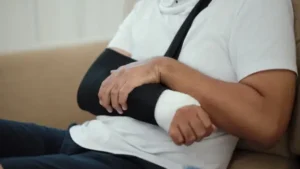Did you end up with a sore, possibly broken elbow? That sharp pain, swelling, or difficulty moving your arm can really put restrictions on your day-to-day life. If you’re sitting there with a broken elbow, wondering just how long this is going to take to recover and what you should be doing to speed up the process, you’ve come to the right place.
In this blog, we’re diving into everything you need to know about dealing with a fractured or broken elbow. From understanding “what exactly an elbow fracture is”, to “navigating the healing journey step by step”, we’ve got you covered. We’ll talk about treatment options, and how physical therapy can be a game-changer.
So, if you’re ready to recover from a broken elbow and get back to your usual self, stick around.
Contents
- 1 Is a Broken Elbow Serious?
- 2 Different Types Of Broken Elbows or Fractures
- 3 First Signs of Broken Elbow
- 4 What Does a Fractured Elbow Look Like?
- 5 Initial Steps After an Elbow Fracture
- 6 Treatment Options To Recover From Broken Elbow
- 7 Recovery from Broken Elbow: What to Expect
- 8 Need Help In Recovery? Visit Us Now!
Is a Broken Elbow Serious?
 A broken elbow can range from a small crack in one of the bones to a full break that goes through the bone or several bones. Your elbow is made up of three bones that can break if you fall on your arm or hit it on something hard.
A broken elbow can range from a small crack in one of the bones to a full break that goes through the bone or several bones. Your elbow is made up of three bones that can break if you fall on your arm or hit it on something hard.
There are different types of breaks, like a simple fracture where the bone cracks but doesn’t move, or more serious ones where the bone breaks into pieces or moves out of place.
Common causes of a broken elbow include: falling directly on the elbow, getting hit by something hard, or trying to stop a fall with your hand, which sends a lot of force up to your elbow.
Whether a broken elbow is serious depends on how bad the break is. While some breaks might need just a cast or a sling to heal, others might need surgery to put the bones back in the right place. However, the seriousness also depends on whether the break damages the area around the elbow, like nerves or blood vessels, which can make recovery harder.
Therefore, understanding the type of break is the first step in getting your elbow and recovery.
Different Types Of Broken Elbows or Fractures
When it comes to broken elbows, not all fractures are the same. Here are some common types of elbow fractures:
- Radial Head Fractures
These occur at the top of the radius bone, right where it meets your elbow. It’s a common injury from falling onto an outstretched hand. - Olecranon Fractures
The olecranon is the pointed bone you can feel when you touch your elbow. These fractures happen from a direct blow or fall onto the elbow. - Distal Humerus Fractures
This type involves the lower end of the upper arm bone (humerus) where it forms the elbow joint. It’s more common in older adults and can be due to a fall. - Supracondylar Fractures
Mostly seen in children, these fractures occur just above the elbow joint on the humerus. They’re often the result of a fall from a height, like a playground equipment. - Elbow Dislocation with Fracture
Sometimes a fall or force can cause both a dislocation and fracture of the elbow, requiring immediate medical attention to prevent long-term damage.
First Signs of Broken Elbow
- Severe pain in the elbow
- Swelling and bruising around the elbow
- Visible deformity or an unusual shape to the elbow
- Inability to move the elbow joint normally
- A feeling of instability in the elbow
- A popping or cracking sound at the time of injury
- Tenderness to the touch around the elbow area
- Numbness or weakness in the arm, wrist, or hand
What Does a Fractured Elbow Look Like?
 A fractured elbow can dramatically alter the appearance of your arm around the elbow joint, presenting a clear visual indication that something is amiss. Here’s what to look out for:
A fractured elbow can dramatically alter the appearance of your arm around the elbow joint, presenting a clear visual indication that something is amiss. Here’s what to look out for:
- In severe fractures, the elbow may look deformed or out of place. The arm might appear bent at an unnatural angle or the bone may protrude.
- The elbow and possibly the entire arm might hold an unusual position that the person is unable to change due to pain or the bone’s displacement.
Visualizing these signs can be quite alarming, and seeing an elbow that’s swollen, bruised, deformed, or positioned oddly should prompt immediate medical attention. An X-ray image typically confirms the fracture by showing the bone’s break or crack, offering a clear view of the injury’s extent and aiding in determining the appropriate treatment for better recovery.
Initial Steps After an Elbow Fracture
 If you suspect you or someone else has fractured their elbow, taking the right steps immediately can make a big difference in recovery. Here’s what to do right after the injury:
If you suspect you or someone else has fractured their elbow, taking the right steps immediately can make a big difference in recovery. Here’s what to do right after the injury:
- Avoid using the injured arm. Try to keep the elbow as still as possible to prevent further injury.
- If possible, immobilize the elbow using a splint or sling. This will help keep the elbow in a fixed position until you can get medical help.
- Wrap ice in a cloth and apply it to the injured area for 20 minutes at a time. This can help reduce swelling and manage pain. **Avoid applying ice directly to the skin.**
- Keep the injured arm elevated above heart level. This can also help reduce swelling and pain.
- Seek Medical Attention: It’s important to get a professional medical evaluation as soon as possible. A doctor can assess the injury through a physical examination and imaging tests like X-rays to confirm the fracture and determine its severity.
- In the first few days following the injury, avoid applying heat to the area or massaging it, as this can increase swelling and worsen the pain.
Taking these initial steps can help manage the immediate effects of a broken elbow and pave the way for a smoother recovery process. Remember, a timely and accurate diagnosis is key to effective treatment and recovery.
Treatment Options To Recover From Broken Elbow
When it comes to treating a broken elbow, the approach varies depending on the fracture’s severity, location, and whether there are additional injuries involved. Here’s an overview of the common treatment methods:
- For less severe fractures where the bones haven’t shifted out of place, a cast or splint may be used to immobilize the elbow, allowing the bones to heal naturally.
- In some cases, particularly when the fracture is stable, a sling might be recommended to limit movement and provide support while the bone heals. This can be especially useful in the early stages of recovery.
Physical Therapy

Physical therapy plays a vital role in the recovery process after a broken elbow, helping you regain strength, mobility, and functionality in the joint. Here are some rehabilitation exercises that your therapist might recommend.
Gentle Flexion and Extension
- How to Do It: Sit with your arm in front of you, elbow at a 90-degree angle. Slowly bend your elbow as much as pain allows, then slowly straighten it out again. Aim for smooth, controlled movements.
- Purpose: This exercise helps maintain elbow movement and prevent stiffness.
Wrist Turns
- How to Do It: With your elbow by your side and bent at 90 degrees, turn your wrist slowly so your palm faces up and then down.
- Purpose: Wrist turns help maintain wrist flexibility, which is important for overall arm function.
Arm Lifts
- How to Do It: Lying down or sitting, keep your arm straight and lift it slowly above your head as far as comfortable. Return to the starting position and repeat.
- Purpose: This exercise works on improving the range of motion and strengthening the muscles around the shoulder and elbow.
Towel Squeeze
- How to Do It: Hold a rolled-up towel in your hand with a gentle grip. Squeeze the towel and hold for a few seconds before releasing.
- Purpose: Towel squeezes help in strengthening your grip and forearm muscles without putting excessive strain on the elbow.
Forearm Pronation and Supination
- How to Do It: Holding a lightweight object like a hammer or kitchen utensil, rest your forearm on a table with your hand over the edge. Rotate your forearm to turn the object inward and then outward.
- Purpose: This exercise strengthens the muscles responsible for rotating the forearm, improving your ability to perform everyday tasks.
Stretching Exercises
- How to Do It: With your arm extended in front of you, use your other hand to gently pull the fingers back towards your body, stretching the forearm muscles. Hold for 15-30 seconds.
- Purpose: Stretching helps maintain muscle flexibility, reducing the risk of stiffness and pain.
It’s crucial to start these exercises only after your healthcare provider gives the go-ahead and to perform them within the limits of your pain threshold. The goal of physical therapy is gradual improvement, so be patient with your progress and communicate openly with your therapist about what feels good and what doesn’t.
Surgery
 Surgery may be necessary for more complicated fractures, such as those where the bone is fragmented, has moved out of place, or involves the joint. Surgical options can include:
Surgery may be necessary for more complicated fractures, such as those where the bone is fragmented, has moved out of place, or involves the joint. Surgical options can include:
- Pinning: Inserting metal pins to hold the bone fragments together while they heal.
- Plates and Screws: Attaching metal plates and screws to the outside of the bone to stabilize and align the fragments.
- Joint Replacement: In severe cases affecting the joint, part or all of the elbow joint may need to be replaced with an artificial joint.
Each treatment option is aimed at ensuring the best possible recovery, minimizing pain, and restoring the elbow’s function. Therefore, it’s important to work closely with your healthcare provider to choose the treatment that best suits your specific situation and to follow their recommendations closely throughout the recovery process.
Recovery from Broken Elbow: What to Expect
 Recovering from a broken elbow varies from person to person, depending on several factors such as the severity of the fracture, the chosen treatment method, and the individual’s overall health.
Recovering from a broken elbow varies from person to person, depending on several factors such as the severity of the fracture, the chosen treatment method, and the individual’s overall health.
Here’s a general overview of what you might expect during the recovery process after a broken elbow:
- For First 1-2 Weeks
During this phase, managing pain and swelling is the primary concern. Treatment may involve immobilization with a cast, splint, or sling.
You’re advised to limit your activities, rest, and avoid putting any strain on the injured elbow. - During Weeks 3-6
Now, as pain starts to decrease, gentle movements and physical therapy may begin to prevent stiffness and improve mobility.
Try out some simple exercises under the guidance of a physical therapist, focusing on gradually increasing the elbow’s range of motion. - Mid Recovery – Weeks 7-12
By this time, you’ll start building strength and flexibility in the elbow, forearm, and wrist.
You may start to return to some everyday activities, as pain allows, but still avoid heavy lifting or strenuous use of the arm. - Late Recovery (3-6 Months)
By this time, you’ll be able to return to normal function, strength, and flexibility. The goal is to resume most daily activities without significant limitations.
You might begin to reintegrate into sports or work-related tasks, with modifications as needed. - Full Healing (6 Months and Beyond)
Finally, after 6 months or beyond, the bone should be fully healed, and attention should shift to regaining full strength and functionality.
You can fully return to activities, sports, and work, assuming no complications.
It’s important to note that these timelines are approximate. Some fractures, especially those requiring surgery, may have longer recovery times. So remember, giving yourself time to recover fully is essential for your long-term health and mobility.
Need Help In Recovery? Visit Us Now!
Recovering from a broken elbow can feel like a long and challenging journey, but you don’t have to go through it alone. Whether you’re in the early stages of managing pain and swelling, or further along and working to regain full strength and mobility, professional guidance can make all the difference.
At MantraCare, we understand the complexities of healing from an elbow fracture and the importance of personalized, expert care. Our skilled physical therapists will work with you to develop a tailored rehabilitation plan, that too from the comfort of your home.
Physical therapy can help you recover from pain.
If you’re experiencing any discomfort including, back pain, shoulder pain, knee pain, neck pain, elbow pain, hip pain, arthritis, or limitations due to a broken elbow or other pains, a physical therapist at MantraCare can assist you. Book a physiotherapy session today and take the first step towards a successful recovery. We’re here to support you every step of the way.


